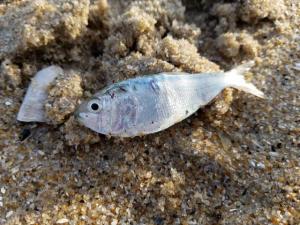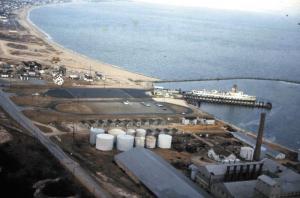Measuring menhaden's importance
Before tourism drove the Cape Region, life was all about that bunker.
The oily bait fish supported Lewes in the mid-1900s, when factories deployed dozens of boats to harvest menhaden, commonly called bunker in the First State.
Even though those factories closed long ago, menhaden still play a vital role as bait for recreational and commercial fishermen - and food for a slew of marine animals.
“Menhaden are an important link in our ecosystem's food web,” said Chris Klarich, campaign manager at the Delaware Nature Society, at a recent public hearing. “While there have been positive signs for the landing menhaden fishery, population numbers, particularly for juveniles, remain at a near-historic low. Additionally, most menhaden predators – like the striped bass, bluefish, cod, osprey, humpback whales – are still on the decline. This illustrates the need for more immediate, ecologically based protection for menhaden.”
The menhaden fishery has been on a roller-coaster ride for decades; in 2011, menhaden were considered overfished, but the population has since stabilized.
That's part of the reason fishery managers along the East Coast might change future management of the species, which has been managed by the Atlantic States Marine Fisheries Commission since 1981.
“Some have called it the most important fish of the sea, and that's because they form the food chain for a great many predators: striped bass, bluefish, seagulls, marine mammals, whales,” said Roy Miller, a retired fish scientist and voting member of the commission. “And menhaden are bait from the day they're born until the day they die.”
The foot-long fish is used as bait for catching crabs and lobsters as well as other species. They're also reduced to other products such as animal feed, fertilizer or Omega-3 fish oil.
Because they are critical to other species, the commission is considering a broader, ecological approach to managing menhaden.
“Menhaden are one of the most important fish in the bays,” said Chris Bason, executive director at the Delaware Center for the Inland Bays. He said studies by the Department of Natural Resources and Environmental Control have found menhaden to be the sixth most abundant fish near the shoreline, and the seventh most abundant fish in open waters off Delaware's coast.
As filter feeders, menhaden also contribute to cleaning up the bays, he said.
“The Inland Bays have a high level of nutrification, so there's a lot of algae floating in the water. To the extent we have a large menhaden population, that means more of those nutrients will be in the fish instead of in the algae.”
The fisheries commission, 15 coastal states that work with federal partners to manage 27 nearshore fish species, is proposing several options to manage menhaden, including its relation to other marine species rather than simply relying on fish population estimates. There are several different options for future management; three representatives from each of the 15 states in the commission will vote in November on which one is the best. The public is invited to comment on those options through Tuesday, Oct. 24.
The proposed options for menhaden management can be found on the Atlantic States Marine Fisheries Commission's website at www.asmfc.org. The deadline for public comment is 5 p.m., Tuesday, Oct. 24. Comments can be emailed to comments@asmfc.org with the subject “Draft Amd. 3,” mailed to Megan Ware, Atlantic States Marine Fisheries Commission, 1050 N. Highland St., Suite 200 A-N, Arlington, VA 22201, by calling 703-842-0740 or by sending a fax to 703-842-0741.
While the commission says menhaden are not overfished, fishery managers have for years considered developing a way to account for changes in the predator species that rely on menhaden when it sets overfishing thresholds, Miller said.
“That's been the plan all along,” he said. “We've just been waiting for these ecosystem models to come to fruition.”
Those models take time. Ecosystem models that show how menhaden populations affect other fish won't be ready for initial review until 2019, and likely won't be ready to be incorporated into management plans until 2020 or later.
Right now, menhaden are managed as if no other species depended upon them, Miller explained.
“That management doesn't take into consideration the menhaden's use as prey for other species,” he said.
The question is, Miller said, whether the commission continues managing menhaden in a bubble, or instead uses limited data to measure menhaden's role in the food chain.
Each of the 15 states represented by the commission, including Delaware, will have an equal voice in the future management of menhaden. Environmental groups like the Delaware Nature Society and Delaware Center for the Inland Bays argued in favor of the ecological approach at a public hearing in September. Others questioned why managers want to fix a system they say isn't broken.
“We're in a very good place with menhaden,” said Leonard Voss, a commercial fisherman and chairman of the state's shellfish advisory council. “I think that of all the species that the commission manages, a reasonable person could argue that this is in the best shape of any of them. It kind of defies logic why you would want to mess with one of your success stories.”
Rich King, a recreational fisherman and owner of Delaware Surf Fishing, said protection of the species and its marine environment is paramount.
He said a more ecologically based method of management would have no adverse effects on Delaware's fishing industries.
Bason agreed.
“Menhaden have a direct link to our recreational fishing economy because they support predator species,” he said. “And even outside of recreational fishing, they support the bald eagles, the osprey and the humpback whales off the coast that people love to see and enjoy watching.”
Menhaden were life in Lewes
Lifelong Lewes resident Rowland Marshall remembers when it was normal to see 40 boats off the coast of Lewes, directed by pilots searching for silvery schools of menhaden from above.
“They used to spot the menhaden from airplanes,” Marshall said. “Then [the boats would] circle a whole school of fish, drop the nets and tie in the bottom of it, and haul them in.” As a 19-year-old apprentice with the pilot's association in the 1940s, Marshall used the same docks as the fishermen.
In the 1950s, Lewes earned the title as the largest seafood port in the country, processing nearly 400 million pounds of seafood – most of it menhaden.
Locals would hope for easterly winds when the plants were at full force.
“Any time the wind was east, the whole town smelled,” Marshall said. “And when they'd be cooking those fish, well, that kept Lewes from being discovered.”
But soon the demand would far outweigh the supply.
“They got so good at it the fish moved south,” the 95-year-old said.
By the time Otis Smith's Fish Products Inc. factory shuttered in 1966, there were no menhaden left to catch, Gary Grunder wrote in an article published in 2000 in the Journal of the Lewes Historical Society.
“Schools often contained 300-500,000 fish, so a lot of fish were harvested rather quickly,” he wrote. “This process and harvest fished out the sea in our area by 1965-66.”
Marshall said Lewes felt the economic impact when the factory closed.
“They fished them out, yep,” Marshall said. “Then tourism came along and replaced it. It's all good.”
Editor’s note: This story has been updated to correct the reference to Gary Grunder’s article published in a Lewes Historical Society journal.
























































